Today, a quick review of the ASUS GeForce GTX 1080 TURBO.
Article index:
1 – Overview
This GTX 1080 TURBO is the simplest GTX 1080 I tested. By simplest, I mean the graphics card comes with a simple VGA cooler (nothing to see with the GTX 1080 Strix!), no factory overclocking and a minimal bundle.
The GTX 1080 TURBO is powered by a Pascal GP104 GPU clocked at 1607MHz (base clock) and 1733MHz (boost clock). Both clock speeds are the reference ones, no out of the box overclocking. The card has 8GB of GDDR5X graphics memory clocked at 10010MHz like NVIDIA reference model.
ASUS GTX 1080 TURBO homepage can be found HERE.
2 – Gallery
The bundle is minimal: the GTX 1080, a user’s guide, a CDROM with drivers + utilities and an invite code for World Warships:

The GTX 1080 TURBO:

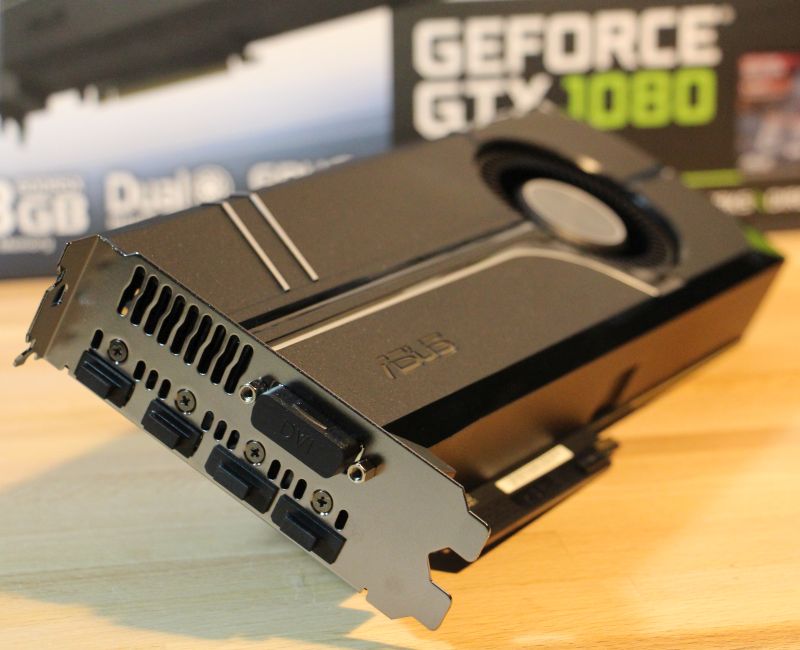
No backplate… not enough expensive to deserve a backplate!

The GTX 1080 TURBO comes with one 8-pin power connector: the total power draw can reach 225W (150W + 75W). The TDP of the reference GTX 1080 is 180W. The diameter of the fan: 65mm.
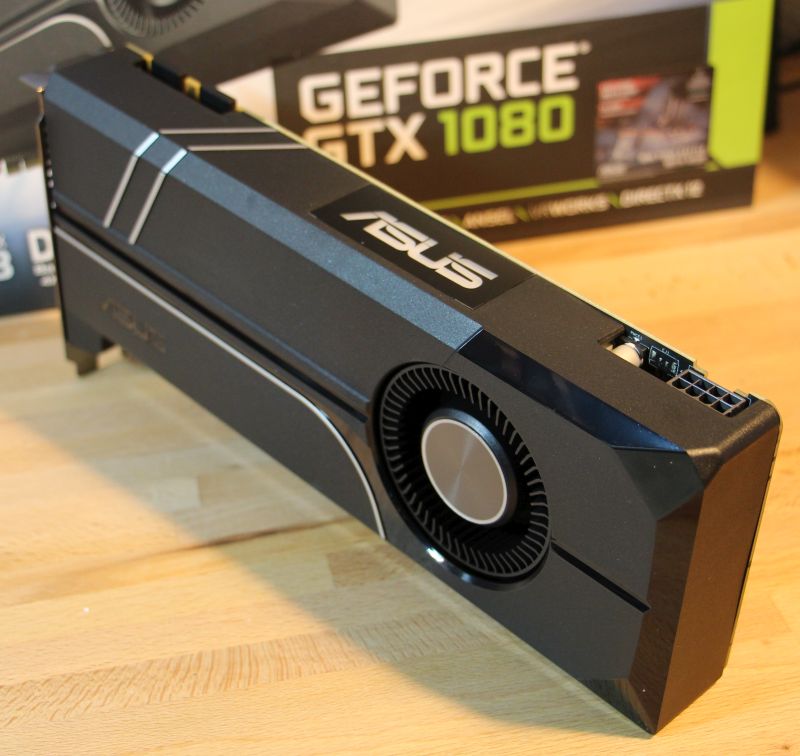
Two DisplayPort 1.4, two HDMI 2.0 and one DVI connectors are present.

A LED is available to indicate a good power supply (white color=OK, red color=ERROR).

The GTX 1080 Turbo versus GTX 1080 Strix.

3 – GPU Data


4 – Benchmarks
Testbed configuration:
– CPU: Intel Core i5 6600K @ 3.5GHz
– Motherboard: ASUS Z170 Pro Gaming
– Memory: 8GB DDR4 Corsair Vengeance LPX @ 2666MHz
– PSU: Corsair AX860i
– Software: Windows 10 64-bit + NVIDIA R376.09
4.1 – 3DMark Sky Diver
| 29024 – ASUS GeForce GTX 1080 Strix – R368.51 |
| 28328 – ASUS GeForce GTX 1080 TURBO – R376.09 |
| 26828 – EVGA GeForce GTX 1070 FTW – R376.09 |
| 25134 – ASUS GeForce GTX 980 Ti – R353.06 |
| 23038 – ASUS GeForce GTX 980 Strix – R344.75 |
| 21964 – MSI Radeon R9 290X Gaming – Catalyst 14.9 WHQL |
| 21811 – Gainward GeForce GTX 970 Phantom – R344.75 |
| 20274 – EVGA GeForce GTX 780 – R344.75 |
| 17570 – MSI Radeon HD 7970 – Catalyst 14.9 WHQL |
| 17533 – EVGA GeForce GTX 680 – R344.75 |
4.2 – 3DMark Fire Strike
Fire Strike is a Direct3D 11 benchmark for high-performance gaming PCs with serious graphics cards.

| 15583 – ASUS GeForce GTX 1080 Strix – R368.51 |
| 14810 – ASUS GeForce GTX 1080 TURBO – R376.09 |
| 13438 – EVGA GeForce GTX 1070 FTW – R376.09 |
| 12514 – ASUS GeForce GTX 980 Ti – R353.06 |
| 10574 – ASUS GeForce GTX 980 Strix – R344.75 |
| 9382 – MSI Radeon R9 290X Gaming – Catalyst 14.9 WHQL |
| 8870 – MSI GTX 970 CLASSIC 4GD5T OC – R344.75 |
| 8203 – EVGA GeForce GTX 780 – R344.75 |
| 6572 – MSI Radeon HD 7970 – Catalyst 14.9 WHQL |
| 6399 – ASUS Strix GTX 960 DC2 OC 4GB – R353.06 |
| 6235 – EVGA GeForce GTX 680 – R344.75 |
4.3 – 3DMark Fire Strike Ultra
| 5125 (Graphics score: 5330) – ASUS GeForce GTX 1080 Strix – R368.51 |
| 4865 – ASUS GeForce GTX 1080 TURBO – R376.09 |
| 4244 – EVGA GeForce GTX 1070 FTW – R376.09 |
| 2617 (Graphics score: 2592) – MSI GTX 970 CLASSIC 4GD5T OC – R368.69 |
| 2178 (Graphics score: 2134) – EVGA GeForce GTX 780 – R368.69 |
4.4 – 3DMark Time Spy
| 6393 (Graphics score: 7449) – ASUS GeForce GTX 1080 Strix – R372.54 |
| 6162 – ASUS GeForce GTX 1080 TURBO – R376.09 |
| 5358 – EVGA GeForce GTX 1070 FTW – R376.09 |
| 4177 (Graphics score: 4274) – EVGA GeForce GTX 1060 SC – R368.81 |
| 3658 (Graphics score: 3640) – MSI Radeon RX 470 Gaming X – Crimson 16.8.2 |
| 3410 (Graphics score: 3382) – MSI GTX 970 CLASSIC 4GD5T OC – R368.69 |
4.5 – FurMark 1.18
FurMark is an OpenGL 2 benchmark that renders a furry donut. This benchmark is known for its extreme GPU workload.
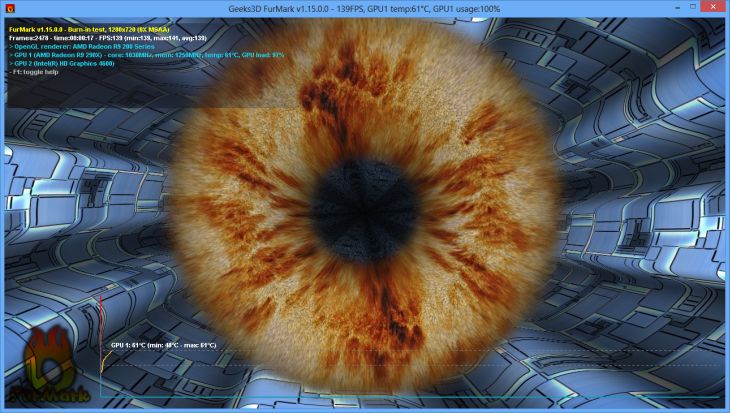
Settings: Preset:1080 (1920×1080)
| 7151 points (119 FPS) – ASUS GeForce GTX 1080 Strix – R368.51 |
| 7063 points (118 FPS) – ASUS GeForce GTX 1080 TURBO – R376.09 |
| 6233 points (103 FPS) – ASUS GeForce GTX 980 Ti – R353.06 |
| 6143 points (102 FPS) – EVGA GeForce GTX 1070 FTW – R376.09 |
| 4660 points (77 FPS) – ASUS GeForce GTX 980 Strix – R344.75 |
| 4592 points (76 FPS) – MSI Radeon R9 290X Gaming – Catalyst 14.9 WHQL |
| 4050 points (67 FPS) – EVGA GeForce GTX 780 – R344.75 |
| 3335 points (55 FPS) – MSI GTX 970 CLASSIC 4GD5T OC – R344.75 |
| 2951 points (49 FPS) – MSI Radeon HD 7970 – Catalyst 14.9 WHQL |
| 2733 points (45 FPS) – EVGA GeForce GTX 680 – R344.75 |
| 2566 points (42 FPS) – ASUS Strix GTX 960 DC2 OC 4GB – R353.06 |
Settings: Preset:2160 (3840×2160)
| 2715 points (45 FPS) – ASUS GeForce GTX 1080 Strix – R368.51 |
| 2624 points (44 FPS) – ASUS GeForce GTX 1080 TURBO – R376.09 |
| 2201 points (37 FPS) – EVGA GeForce GTX 1070 FTW – R376.09 |
| 1385 points (23 FPS) – EVGA GeForce GTX 780 – R368.69 |
| 1339 points (22 FPS) – MSI GTX 970 CLASSIC 4GD5T OC – R368.69 |
4.6 – Resident Evil 6 Benchmark
Resident Evil 6 (RE6) is a Direct3D 9 benchmark. RE6 benchmark can be downloaded from this page.

Settings: Resolution: 1920 x 1080, anti-aliasing: FXAA3HQ, all params to high.
| 21410 points – ASUS GeForce GTX 1080 Strix – R372.54 |
| 21295 points – ASUS GeForce GTX 1080 TURBO – R376.09 |
| 20869 points – EVGA GeForce GTX 1070 FTW ACX3.0 – R376.09 |
| 18527 points – EVGA GeForce GTX 1060 SC – R372.54 |
| 16332 points – MSI GTX 970 Classic – R353.06 |
| 14522 points – MSI Radeon R9 290X Gaming 4GB – Crimson 16.8.2 |
| 13789 points – MSI Radeon RX 470 Gaming X 8GB – Crimson 16.8.2 |
| 13405 points – EVGA GTX 780 – R353.06 |
| 11935 points – ASUS Strix GTX 960 DC2 OC 4GB – R353.06 |
| 11442 points – EVGA GTX 680 – R353.06 |
| 8794 points – MSI GTX 660 Hawk – R353.06 |
| 5714 points – ASUS GTX 750 + R353.06 |
| 4495 points – ASUS G551Jw notebook w/ GTX 960M 4GB + R353.06 |
4.7 – Unigine Valley 1.0
Unigine Valley is a Direct3D/OpenGL benchmark from the same dev team than Unigine Heaven. More information can be found HERE and HERE.

Settings: Extreme HD (Direct3D 11, 1920×1080 fullscreen, 8X MSAA)
| 102.0 FPS, Score: 4269 – ASUS GeForce GTX 1080 Strix – R372.54 |
| 101.0 FPS, Score: 4227 – ASUS GeForce GTX 1080 TURBO – R376.09 |
| 90.5 FPS, Score: 3788 – EVGA GeForce GTX 1070 FTW ACX3.0 – R376.09 |
| 86.1 FPS, Score: 3602 – ASUS GeForce GTX 980 Ti – R353.06 |
| 68.0 FPS, Score: 2846 – EVGA GeForce GTX 1060 SC – R372.54 |
| 67.8 FPS, Score: 2837 – ASUS GeForce GTX 980 Strix – R344.75 |
| 63.3 FPS, Score: 2648 – MSI Radeon R9 290X Gaming – Crimson 16.8.2 |
| 58.7 FPS, Score: 2457 – Gainward GeForce GTX 970 Phantom – R344.75 |
| 57.8 FPS, Score: 2418 – EVGA GeForce GTX 780 – R344.75 |
| 56.0 FPS, Score: 2344 – MSI GTX 970 CLASSIC 4GD5T OC – R344.75 |
| 46.4 FPS, Score: 1942 – MSI Radeon RX 470 Gaming X 8GB – Crimson 16.8.2 |
| 42.9 FPS, Score: 1796 – EVGA GeForce GTX 680 – R344.75 |
| 39.9 FPS, Score: 1668 – MSI Radeon HD 7970 – Catalyst 14.9 WHQL |
| 35.8 FPS, Score: 1500 – ASUS Strix GTX 960 DC2 OC 4GB – R353.06 |
| 34.6 FPS, Score: 1446 – EVGA GeForce GTX 580 – R344.75 |
| 32.4 FPS, Score: 1358 – MSI GTX 660 Hawk – R353.06 |
| 29.3 FPS, Score: 1224 – Sapphire Radeon HD 6970 – Catalyst 14.9 WHQL |
| 25.6 FPS, Score: 1071 – EVGA GeForce GTX 480 – R344.75 |
| 19.4 FPS, Score: 812 – ASUS GeForce GTX 750 – R344.75 |
| 16.2 FPS, Score: 679 – ASUS Radeon HD 7770 DC – Catalyst 14.9 WHQL |
5 – Burn-in Test
Testbed configuration:
– CPU: Intel Core i5 6600K @ 3.5GHz
– Motherboard: ASUS Z170 Pro Gaming
– Memory: 8GB DDR4 Corsair Vengeance LPX @ 2666MHz
– PSU: Corsair AX860i
– Software: Windows 10 64-bit + NVIDIA R376.09
At idle state, the total power consumption of the testbed is 38W. The GPU temperature is 30°C. The VGA cooler is barely audible but we can hear it (open case).
To stress test the GTX 1080 TURBO, I’m going to use the latest FurMark 1.18.2. A resolution of 1024×768 is enough to stress test the graphics card.
The first stress test is done with the default power target: 100%TDP. After 5 minutes, the total power consumption of the testbed was 233W and the GPU temperature was 79°C.
Before starting the second stress test, I quickly launched MSI Afterburner and set the power target to the maximal value. For this GTX 1080 TURBO, the max value is 120%TDP. Now results are a bit different: the total power consumption jumped to 267W and the GPU temperature reached 83°C. The VGA cooler was noisy…

An approximation of the graphics card power consumption is:
P = (267 – 38 – 20) x 0.9
P = 188W @ 120%TDP
where 0.9 the the power efficiency factor of the Corsair AX860i PSU, and 20W is the additional power draw of the CPU.
Thermal Imaging
Idle state
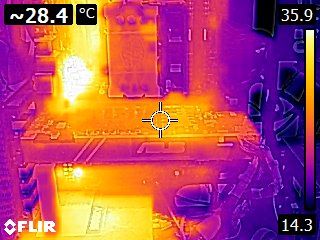
Load state
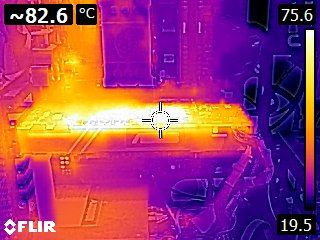
6 – Conclusion
This GTX 1080 TURBO is a basic GTX 1080. The performances are good and in the expected range for a GTX 1080 but that’s all. The card has a cheap VGA cooler: at idle the noise is barely audible (good!) but under heavy load, the cooler is noisy (not good!!). And the 0dB fan technology we can find on other models? Not present… This kind of VGA cooler should not be there: it’s a GTX 1080 and a high-end graphics card based on a GP104 GPU deserves a decent VGA cooler.
The GPU temperature at idle state is good (30°C) but can exceed 80°C on load. There is no backplate for mechanical protection and heat dissipation. Compared to other models like the GTX 1080 Strix, this card is cheaper. So if you really need a GTX 1080 for its graphics performances but you don’t want to spend too much money, this is your card.
Now if you hesitate, maybe a graphics card like the EVGA GTX 1070 FTW would be a better choice: very good performances, noiseless and cheaper…

Thanks to Internex for this ASUS GTX 1080 Turbo!

GTX 1080 Strix only 7151 pts!?! and GTX 980 Ti only 6233!?! lol
But…
Furmark 1.18.2.0 – 1080p preset running Win 10 1st anniversary:
— 100% power: 8273 pts (avg 138 fps; min 136; max 142) at ~1000MHz (I think) core and max temp 57ºC
— 110% power: 9095 pts (avg 152 fps; min 151; max 154) at 1139MHz core and max temp 58ºC
My specs: i7-4790K@4.7GHz and GTX 980 Ti SC+ 379.06WHQL (HQ)
My room is 18ºC
Can you remember my old GTX 480 (nov 2010 – jun 2014), GTX 580 3GB and GTX 780 Ti Classified* and I’m nuninh1980? 😀
* – 780 Ti Classy was replaced to 980Ti SC+ by EVGA RMA due to the “render failed” issue on Octane Render. This new card gets amazing performance.. 😀
ooh!! 376.09WHQL driver. sorry.